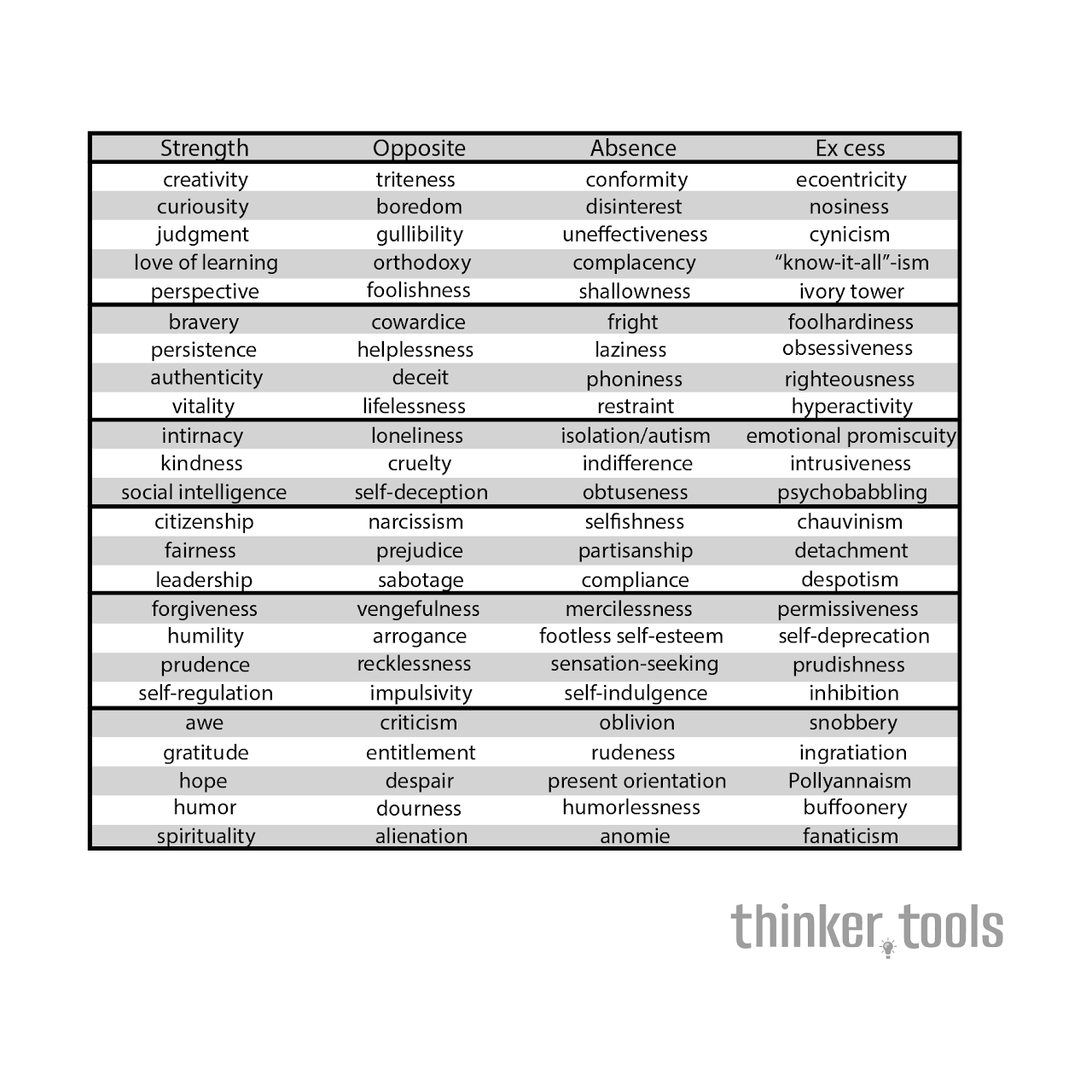
What is the Strengths & Weaknesses Framework?
The Strengths & Weaknesses framework is a comprehensive assessment tool that helps identify, understand, and strategically work with personal capabilities and limitations. Unlike simplistic labeling, this framework views strengths and weaknesses as dynamic, context-dependent qualities that can be developed, compensated for, or strategically deployed.
The framework recognizes that strengths overused can become weaknesses, weaknesses in one context might be strengths in another, and the most effective approach often involves leveraging strengths while managing weaknesses rather than trying to eliminate them entirely.
The History and Origin
The systematic study of strengths and weaknesses has evolved through multiple influences. Peter Drucker pioneered the concept of managing oneself by understanding strengths in his management writings. The positive psychology movement, led by Martin Seligman and others, shifted focus from fixing weaknesses to building on strengths.
Donald Clifton's work at Gallup led to StrengthsFinder, emphasizing that people succeed by maximizing strengths rather than fixing weaknesses. Meanwhile, tools like SWOT analysis (Strengths, Weaknesses, Opportunities, Threats) made systematic assessment standard in business strategy. This framework synthesizes these approaches into a practical tool for personal and interpersonal development.
How to Use the Strengths & Weaknesses Framework
Step 1: Create a Comprehensive Inventory
For self-assessment, consider:
- Natural talents: What comes easily to you?
- Learned skills: What have you developed through practice?
- Energy indicators: What activities energize vs. drain you?
- Feedback patterns: What do others consistently say about you?
- Success patterns: Where have you repeatedly succeeded?
- Struggle patterns: Where do you consistently face challenges?
Step 2: Categorize Thoughtfully
Organize findings into categories:
- Core Strengths: Natural talents that energize you
- Developed Strengths: Skills built through effort
- Contextual Strengths: Abilities that shine in specific situations
- True Weaknesses: Gaps that significantly impact performance
- Irrelevant Weaknesses: Limitations that don't matter for your goals
- Hidden Strengths: Underdeveloped potential
Step 3: Analyze Patterns and Connections
Look for relationships:
- How do strengths and weaknesses connect?
- Which weaknesses are overused strengths?
- What themes emerge across categories?
- How do context and role affect these qualities?
Step 4: Develop Strategic Approaches
For Strengths:
- Find roles and projects that utilize them
- Develop them further through deliberate practice
- Teach others to multiply impact
- Watch for overuse that creates problems
For Weaknesses:
- Determine which truly need addressing
- Develop minimum viable competence where necessary
- Partner with others who have complementary strengths
- Create systems to compensate
Step 5: Apply to Others
When assessing others:
- Observe behavior patterns across situations
- Ask about their self-perception
- Notice energy and engagement levels
- Consider context and role fit
- Avoid fixed mindset labeling
Step 6: Create Development Plans
Build actionable plans:
- Set specific goals for strength development
- Identify weakness mitigation strategies
- Create accountability measures
- Schedule regular reassessment
Practical Examples
Career Development: Jennifer, a software developer, identifies her strengths as problem-solving and deep focus, but weakness in presentation skills. Rather than avoiding presentations, she partners with a colleague strong in communication for important demos while gradually building basic presentation competence.
Team Building: A manager maps team members' strengths and weaknesses, discovering that perceived "conflicts" arise from complementary abilities. The detail-oriented analyst and the big-picture strategist learn to value their different perspectives as strengths that balance each other.
Personal Relationship: Partners recognize that one's strength in planning complements the other's spontaneity. Instead of seeing these as incompatible, they create a rhythm that includes both structured plans and flexibility for adventure.
Parenting Application: Parents identify their child's strength in creative thinking but weakness in organization. They nurture the creativity while teaching organizational systems that work with, not against, the child's natural thinking style.
Benefits and Life Impact
Mastering the Strengths & Weaknesses framework transforms how you approach personal development and relationships:
Enhanced Self-Awareness: Deep understanding of your capabilities and limitations enables better life choices and career decisions aligned with your authentic self.
Improved Performance: Focusing on strength development while managing weaknesses leads to higher achievement than trying to be good at everything.
Better Team Dynamics: Understanding diverse strengths and weaknesses helps create complementary teams where members' abilities synergize rather than clash.
Reduced Frustration: Accepting weaknesses (yours and others') as normal reduces self-criticism and judgment, creating more compassion and realistic expectations.
Strategic Living: You make better choices about where to invest energy, what opportunities to pursue, and when to seek help or collaboration.
Growth Mindset: Viewing strengths and weaknesses as dynamic rather than fixed encourages continuous development and learning.
Improved Relationships: Understanding others' strengths and weaknesses builds empathy and helps you support them more effectively.
Career Satisfaction: Aligning work with strengths while managing weaknesses leads to greater engagement and success.
Efficient Development: Focused improvement efforts on relevant areas yield better results than scattered attempts to fix everything.
The Strengths & Weaknesses framework offers a mature approach to human capability – neither denying limitations nor being defined by them. It recognizes that excellence comes not from being well-rounded but from being sharply pointed in areas of strength while adequately managing weaknesses. This framework transforms assessment from a judgment exercise into a strategic tool for deployment and development. Whether applied to yourself, your team, or your relationships, it provides a roadmap for creating environments where everyone can contribute their best while being supported in areas of challenge. In a world that often demands perfection, this framework offers a more human and ultimately more effective path: know yourself, play to your strengths, manage your weaknesses, and collaborate with others who complement your abilities.